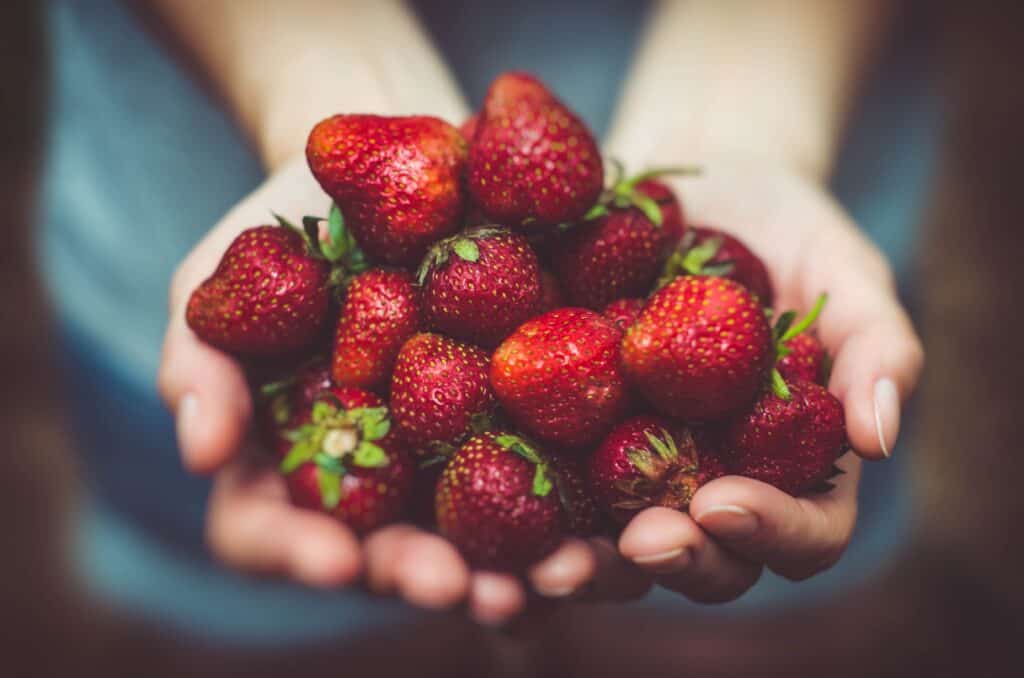Exploring four evidence-based ways to improve wellbeing
Happiness is a complex and multifaceted state of being that can often feel elusive. Whilst it’s easy to attribute our moods to external circumstances, research suggests that happiness can be nurtured through everyday practices and lifestyle choices. In this blog post we explore four evidence-based approaches that can help contribute to feeling happy: everyday creativity, the gut microbiome, embracing seasonal changes, and mindfulness.
Everyday creativity

You don’t have to be an artist to experience the joy that creativity brings. Engaging in everyday creative activities has been found to have a profound impact on happiness and overall well-being (Conner, DeYoung and Silvia, 2018). Research highlights creativity can significantly uplift mood, with activities such as expressive writing even helping to defend the body against infection (Petrie et al, 2004). In addition, creativity is linked to positive well-being, fostering a sense of connection and motivation across various ages and locations (Bone and Fancourt, 2022).
Researchers are still not sure why there is this link, however one theory proposes engaging in a creative activity allows us to get into a ‘flow state’. This state involves the person becoming fully immersed and engaged in the task they are carrying out. This then helps to reduce the amount of unwanted negative thoughts leading to a heightened wellbeing (Bassi et al, 2014). In addition, researchers have suggested the link between creativity and happiness may lie in neuroscience. Studies have shown that anticipation of creative engagements such as art, music and dance increases the brain’s dopamine levels, a neurotransmitter associated with pleasure and reward (Stark, Vuust and Kringelbach 2018).
There are a number of ways you can engage in everyday creativity:
- Being creative with food by cooking a new recipe or trying flavours you haven’t tried before – 30+ Creative Dinner Recipes to Cook at Home | Ambitious Kitchen
- Taking a walk in nature – making sure to take note of the colours you see and the textures of the trees and plants – Find a forest or woodland | Forestry England
- Mindful photography involves fully immersing yourself in the environment and capturing images that connect you to that environment – https://silvotherapy.co.uk/articles/mindful-photography
- 5 minute doodles can be done in the spare minutes you have in your day, maybe whilst waiting for the kettle to boil or waiting at a bus stop – https://mindfulartstudio.com/15-drawing-ideas-you-can-do-in-5-minutes/
- Writing a blog post on a topic you know a lot about, maybe you could create a video or a well designed infographic to go with it – https://blog.hubspot.com/marketing/how-to-start-a-blog
- Mutually sharing learning and knowledge with someone, sharing information on a topic you are passionate about and learning about something you are not familiar with can increase quality of life (Eckhaus and Sheaffer, 2019).
- Dancing to your favourite song, maybe take a couple of minutes to put your favourite song on your headphones or on the computer and dance along in a way that feels best for you – https://www.youtube.com/
The gut microbiome

A healthier gut not only supports optimal digestion but also has the potential to modulate stress, enhance calmness, and improve overall emotional resilience. If you want to find out more about the science behind the gut microbiome and happiness read on, if not you can skip to the ways you can help improve your gut microbiome.
The intricate relationship between our gut and brain, known as the gut-brain axis, reveals a profound and complex connection between gastrointestinal health and mental well-being. This network links the gastrointestinal tract to the central nervous system through the vagus nerve, hormones, and neurotransmitters, creating a dynamic communication pathway between our gut and brain (Chen et al, 2021). The gut microbiome, a diverse community of microorganisms residing in the digestive system, plays a crucial role in this interaction by producing essential neurotransmitters like serotonin and dopamine. These chemicals are vital for regulating mood, emotional states, and overall mental health. When the gut is inflamed, which can be caused by poor diet, stress, or infections, it can lead to chronic inflammation that has been linked to various mental health conditions, including depression and anxiety (Madison and Kiecolt-Glaser, 2019). Reducing inflammation in the gut through a balanced diet, incorporating anti-inflammatory foods, and supporting gut health with probiotics can help restore this balance.
For more information on the science behind the gut microbiome and the gut brain axis follow these links:
- Gut brain axis – https://psychscenehub.com/psychinsights/the-simplified-guide-to-the-gut-brain-axis/
- Gut microbiome – https://www.bmj.com/content/361/bmj.k2179
Here are some ways you can move towards having a healthier gut microbiome:
- Eating anti-inflammatory food such as antioxidant rich foods like berries and leafy greens (Bolte et al, 2021).
- Eating a diverse diet is important, incorporate a rainbow of fruits and vegetables where possible – eat_your_5_a_day.pdf (elht.nhs.uk)
Embracing seasonal changes

The changing seasons offer unique opportunities to find happiness in the rhythms of nature. Each season brings its own beauty and activities that can enhance our lives. Embracing nature and the changing seasons can significantly enhance happiness and well-being. Research indicates that low temperatures can increase happiness and reduce tiredness and stress, while high temperatures tend to reduce happiness (Connolly, 2013). This finding suggests that cooler climates might inherently foster better mental states. Additionally, people living in conditions characterised by higher temperatures, higher visibility, light wind, lower dew points, and an improving economic situation generally report higher happiness levels, pointing to a nuanced interaction between weather conditions and economic factors in determining overall happiness (Peng et al, 2016).
Seasonal light levels also play a crucial role in mood regulation. During the summer, higher light levels boost serotonin production in the brain, enhancing mood and well-being (Raison et al, 2015). Conversely, lower light levels in winter can lead to decreased serotonin levels, often resulting in seasonal affective disorder (SAD) and other mood dips (Selhub and Logan, 2012). Furthermore, a study in Belgium found that healthy young people’s ability to maintain sustained attention peaked around the winter solstice and was at its lowest around the summer solstice (Meyer et al, 2016). This suggests that cognitive functions such as attention might be more finely tuned to darker, cooler months. The same study also noted that working memory performance was highest in autumn and lowest in spring, indicating that our mental capacities are closely tied to seasonal changes (Meyer et al, 2016).
Here are some ways you can embrace seasonal changes:
- Using light therapy (Rosenthal, 2023) during the shorter days of winter can help maintain serotonin levels and mood stability.
- Engaging in outdoor activities, regardless of weather conditions, can boost vitamin D levels and enhance overall well-being – https://www.nationaltrust.org.uk/
- Staying hydrated and eating seasonal foods are simple yet effective ways to stay in harmony with the environment and support our body’s natural rhythms – https://eatseasonably.co.uk/
Mindfulness

Incorporating mindfulness into daily life can profoundly impact mental health by significantly reducing stress and anxiety, breaking negative thought patterns, and enhancing overall emotional well-being (Burch and Penman,2013). Mindfulness encourages individuals to observe their thoughts and feelings non-judgmentally, which disrupts the automatic cycles of worry and rumination that often fuel stress and anxiety. By focusing on the present moment, mindfulness allows us to step back from their habitual reactions and gain perspective, thus alleviating the intensity of negative thought patterns. This practice is instrumental in improving emotional regulation, as it cultivates a meta-awareness—an elevated level of consciousness that helps individuals recognize and understand their emotional responses and thought processes with greater clarity (Holas and Jankowski, 2013).
Mindfulness can be practiced in various ways:
- Mindful walking involves being aware of yourself and your environment as you move through it, you might want to focus on how different muscles feel in your body as you walk or what nature sounds you can hear – https://www.bupa.co.uk/newsroom/ourviews/mindful-walking-meditation
- Mindful breathing is a way of simply focusing your attention on your breaths, there are lots of simple breathing exercises you can do such as box breathing and a short breath meditation – Mindfulness Audio Downloads (bangor.ac.uk)
- Mindful pauses involve staying still and mindfully engaging with your surroundings for a couple of minutes, you might choose to look out a window or close you eyes and think about how your body feels in your seat – https://www.mentalhealthireland.ie/the-mindful-pause/
- Mindful eating involves paying full attention to the experience of eating by taking time to recognise the smells, tastes and textures of the food you are eating – https://www.bda.uk.com/resource/mindful-eating.html
Conclusion
Happiness is not a destination but a journey that involves cultivating positive habits and attitudes. By incorporating everyday creativity, nurturing your gut microbiome, embracing seasonal changes, and practicing mindfulness, you can create a more joyful and fulfilling life. Remember, small daily actions can lead to significant changes in your overall well-being but not all of the above suggestions will work for everyone, so make sure you find what works for you.
Want more?
If you would like to find more ways you can reduce your stress levels, foster resilience and boost happiness head over to watch the resilience workshops we delivered in partnership with Thrive London here.
In addition, if you would be interested in hosting a resilience and stress management workshop for your workforce please get in touch!
References
- Bassi, M., Steca, P., Monzani, D., Greco, A., & Delle Fave, A. (2014). Personality and optimal experience in adolescence: Implications for well-being and development. Journal of Happiness Studies, 15, 829-843.
- Bolte, L. A., Vila, A. V., Imhann, F., Collij, V., Gacesa, R., Peters, V., … & Weersma, R. K. (2021). Long-term dietary patterns are associated with pro-inflammatory and anti-inflammatory features of the gut microbiome. Gut, 70(7), 1287-1298.
- Bone, J., & Fancourt, D. (2022). Arts, Culture & the Brain: A literature review and new epidemiological analyses.
- Burch, V., & Penman, D. (2013). Mindfulness for health: a practical guide to relieving pain, reducing stress and restoring wellbeing. Hachette UK.
- Chen, Z., Maqbool, J., Sajid, F., Hussain, G., & Sun, T. (2021). Human gut microbiota and its association with pathogenesis and treatments of neurodegenerative diseases. Microbial Pathogenesis, 150, 104675.
- Conner, T. S., DeYoung, C. G., & Silvia, P. J. (2018). Everyday creative activity as a path to flourishing. The Journal of Positive Psychology, 13(2), 181-189.
- Connolly, M. (2013). Some like it mild and not too wet: The influence of weather on subjective well-being. Journal of Happiness Studies, 14, 457-473.
- Eckhaus, E., & Sheaffer, Z. (2019). Happiness enrichment and sustainable happiness. Applied Research in Quality of Life, 14, 1079-1097.
- Holas, P., & Jankowski, T. (2013). A cognitive perspective on mindfulness. International Journal of Psychology, 48(3), 232-243.
- Madison, A., & Kiecolt-Glaser, J. K. (2019). Stress, depression, diet, and the gut microbiota: human–bacteria interactions at the core of psychoneuroimmunology and nutrition. Current opinion in behavioral sciences, 28, 105-110.
- Meyer, C., Muto, V., Jaspar, M., Kussé, C., Lambot, E., Chellappa, S. L., … & Vandewalle, G. (2016). Seasonality in human cognitive brain responses. Proceedings of the National Academy of Sciences, 113(11), 3066-3071.
- Peng, Y. F., Tang, J. H., Fu, Y. C., Fan, I. C., Hor, M. K., & Chan, T. C. (2016). Analyzing personal happiness from global survey and weather data: A geospatial approach. Plos one, 11(4), e0153638.
- Petrie, K. J., Fontanilla, I., Thomas, M. G., Booth, R. J., & Pennebaker, J. W. (2004). Effect of written emotional expression on immune function in patients with human immunodeficiency virus infection: a randomized trial. Psychosomatic medicine, 66(2), 272-275.
- Raison, C. L., Hale, M. W., Williams, L. E., Wager, T. D., & Lowry, C. A. (2015). Somatic influences on subjective well-being and affective disorders: the convergence of thermosensory and central serotonergic systems. Frontiers in Psychology, 5, 1580.
- Rosenthal, N. E. (2023). Defeating SAD (Seasonal Affective Disorder): A Guide to Health and Happiness Through All Seasons. Gildan Media LLC aka G&D Media.
- Selhub, E. M., & Logan, A. C. (2012). Your brain on nature: The science of nature’s influence on your health, happiness and vitality. John Wiley & Sons.
- Stark, E. A., Vuust, P., & Kringelbach, M. L. (2018). Music, dance, and other art forms: New insights into the links between hedonia (pleasure) and eudaimonia (well-being). Progress in brain research, 237, 129-152.
